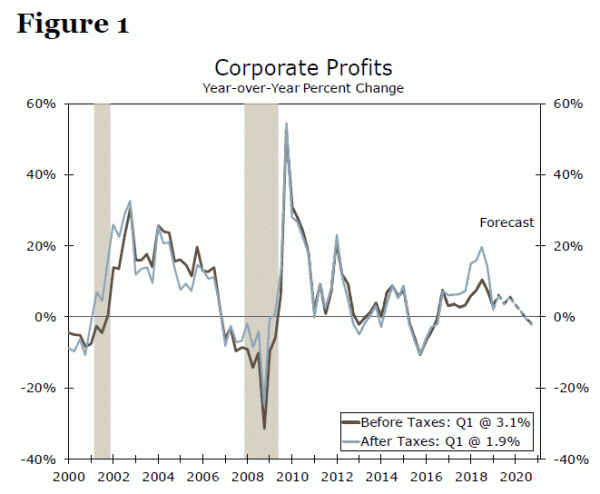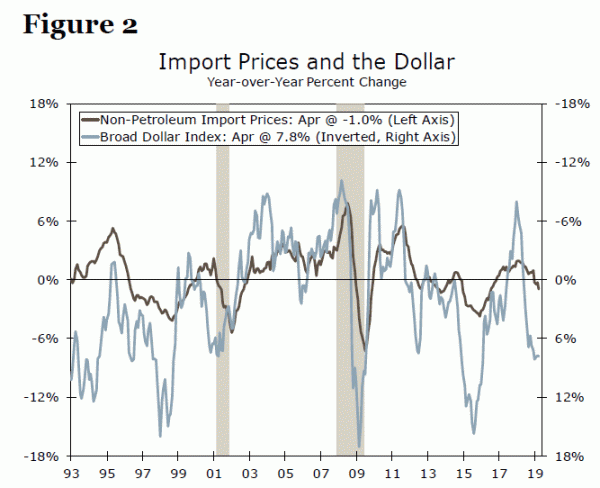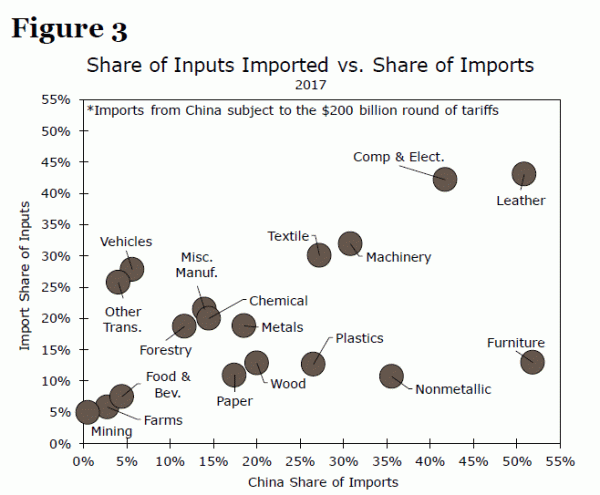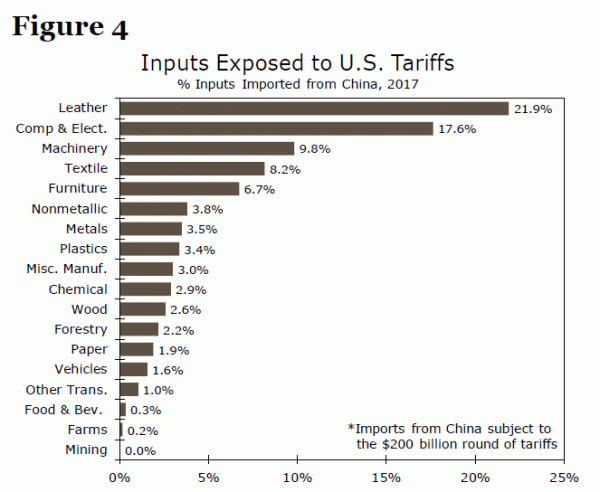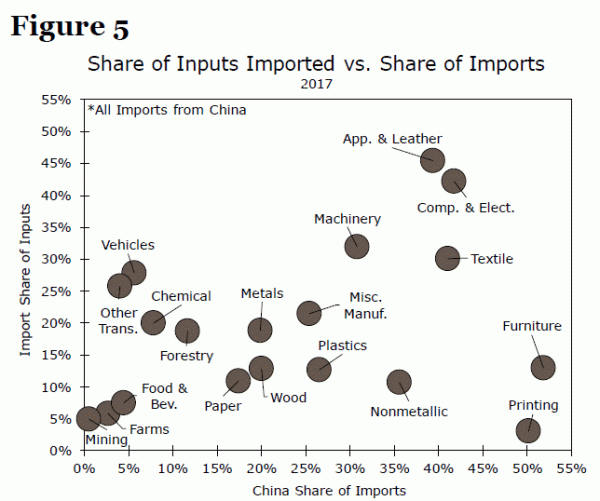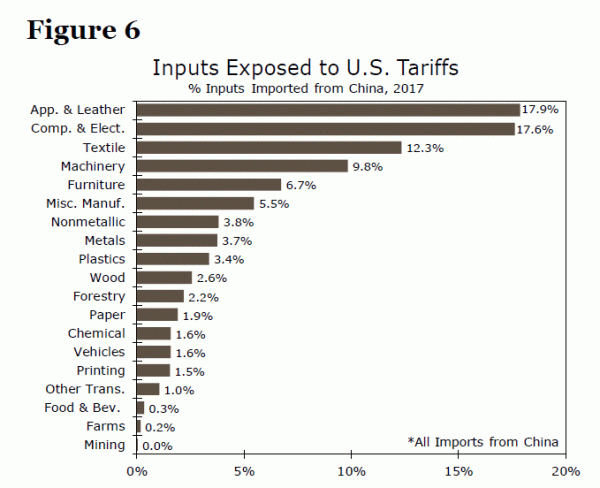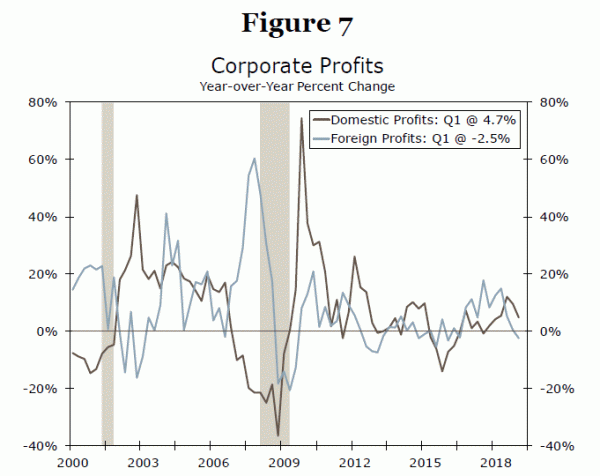Executive Summary
The most recent escalation in the U.S.-China trade war increased the tariff rate to 25% on approximately $200 billion of U.S. imports from China. With approximately 45% of Chinese goods now subject to a 25% tariff, the complete avoidance of additional costs due to tariffs looks unfeasible for most industries. Industry exposure to tariffs on Chinese goods, however, does vary. In this note, we calculate industry exposure to the most recent round of tariffs on Chinese goods as well as the exposure if 25% tariffs are extended to the remaining imports from China. Leather, computer & electronics, machinery, textiles and furniture appear most exposed to higher input costs related to the latest tranche of tariffs. If tariffs are extended to all imports from China, the apparel industry joins the ranks of highly exposed industries.
There is potential for U.S. producers of goods exposed to tariffs to see stronger profit growth as less foreign competition allows these firms to increase prices and/or gain market share. However, we suspect a weakening in demand associated with higher prices and widening net of industries exposed to tariffs will more than offset any gain in profits for U.S.-based producers.
Trade War Risks to Corporate Profits
As we wrote in a recent report, corporate profit growth has held up fairly well over the past year.1 Although after-tax profit growth slowed in the first quarter, the deceleration largely reflected a tougher base comparison now that the reduction in the corporate tax rate is a full year behind us. At 1.9%, before-tax profit growth has slowed only slightly over the past two quarters. We expect profit growth to downshift further this year as broad economic growth loses some momentum amid fading fiscal stimulus and as a tight labor market pushes employment costs higher (Figure 1).
The ongoing U.S.-China trade war, however, could upend our forecast for moderate profit growth through year-end. Tariffs are a tax on imports. Businesses that import these goods can deal with their higher costs through a number of channels, including pushing back on costs from foreign suppliers and/or passing the tariff cost to consumers. But for many businesses, a complete avoidance of additional costs due to tariffs is unfeasible.
Unless demand is inelastic (i.e., the quantity demanded by consumers is completely unresponsive to price) importers end up absorbing part of the tariff. Finding new supply chains that bypass China is an option, but that option entails costs, at least in the short run. A stronger dollar may push the starting value of goods subject to tariffs down, but with most trade already invoiced in dollars, currency adjustment is likely to have a fairly minimal effect (Figure 2). Recent research has found that almost all of the cost of tariffs have been borne by U.S. importers and consumers.2,3
The initial 25% tariffs on $50 billion of Chinese goods that went into effect last summer applied to only about 8% of imports from China and equated to less than 2% of total U.S. imports. Now with 25% tariffs on another $200 billion of goods from China in effect, the heat on U.S. firms reliant on goods from China has been turned up. Not only are import costs of Chinese goods poised to jump under the widening net of tariffs, but non-Chinese producers—American or other foreign companies—could take the opportunity to raise prices.
The extent to which non-Chinese producers do so, however, will depend at least in part on how large a role Chinese products play in the U.S. market. In industries where Chinese-made products account for only a small share of inputs, costs are unlikely to change much even with the application of tariffs, as alternative sources are widely available. For industries with a large share of inputs from China, prices stand to rise more from both the direct and indirect impact of tariffs.4
Profit Pain by Industry
Which industries then are most exposed to a tariff-induced profit squeeze? To answer this question, we first look at the goods affected by the most recent tariff tranche (the $200 billion of goods now subject to 25% tariffs) using the Harmonized Commodity Description and Coding System (HS). Some of the largest categories in value terms exposed to the latest round of tariffs include electric machinery, nuclear reactors, furniture & bedding, plastics and motor vehicles & parts. However, China does not necessarily account for a large share of imports for each of the affected categories. For example, while imports of motor vehicles & parts is the fifth largest category hit by the last round of tariffs, only a small slice—5.6%—of this industry’s imports come from China.
We then turn to the input-output tables of the United States to determine what share of each industry’s inputs is derived from imports.5 China may be a large import source for some industries like nonmetallic minerals (36% of imports), but imports account for a relatively small share of inputs (11%) for the industry (Figure 3). If only a small share of an industry’s inputs are imported, profits should be relatively insulated from the tariffs on Chinese goods.
Using both the HS trade data and the input-output tables, we calculate the share of an industry’s inputs directly subject to the $200 billion round of tariffs. To do this, we determine the share of imports that come from China and multiply that by the share of an industry’s inputs that are imported. As shown in Figure 4, leather manufacturers are hardest hit by the latest round of tariffs, with more than 20% of inputs directly exposed. Computers, electronics & electrical equipment also have high levels of exposure. Non-Chinese producers will have more scope to increase prices as competitors’ costs rise, generating upward pressure on these input costs. Industries with less pressure from the tariffs include mining, farming, food & beverages, motor vehicles and other transportation (largely aerospace), as China accounts for a relatively small share of imports and/or the United States does not import much of those products anyway.
Thus far, the Trump administration has directed tariffs largely toward intermediate products to mitigate the impact of tariffs on consumers. Therefore, consumer-facing industries like apparel and toy manufacturing have not yet faced notable profit pressure. An all-out trade war with China, where 25% tariffs are applied to all imports, would change that picture (Figure 5). Taking into account all imports from China and their relative share of inputs shows that the apparel & leather industries stand to see the most pressure from higher input costs—whether directly via higher costs of Chinese goods or indirectly via less import competition (Figure 6). Textiles, furniture and miscellaneous manufacturing (which includes industries like toys, where 80% of imports come from China) also is at a relatively high risk of profit erosion, along with computer & electronics as well as machinery.
But Won’t U.S. Producers Make Higher Profits?
Admittedly, U.S. producers of goods exposed to tariffs could see a boost to profits as less foreign competition allows them to increase prices and/or gain market share. However, we are skeptical that the profit gains of U.S. producers in protected industries would more than offset the profit losses of import-using firms.
Research on the tariffs implemented in 2018 shows that U.S. producers facing less import competition did indeed raise prices, but by only about 1%.6 At the same time, some U.S. producers manufacturing goods in industries in which Chinese imports are now subject to tariffs may see some of their own input costs rise. For example, machinery manufacturers may be able to raise prices given less import competition, but the metals used to make the machinery is also more expensive due to tariffs. In addition, retaliatory tariffs and the strength of the dollar would exert headwinds on U.S. export growth.
There are also other macroeconomic effects to consider. The uncertainty caused by the current trade environment is hardly conducive to strong investment spending, especially in industries that have a fair amount of export exposure. In addition, a tariff-induced increase in consumer prices would erode real income growth and weigh on growth in consumer spending. In short, an all-out trade war would lead to slower sales and profit growth. And the slowdown need not be confined to the United States. As the trade environment inflicts pain on the global economy more generally, U.S. profits earned abroad would also weaken, as has been the case over the past year (Figure 7).
Conclusion: Weaker Profit Growth a Headwind to Growth
Corporate profit growth was already poised for a slowdown this year following the fading effects of last year’s corporate tax cuts and fiscal stimulus more generally. But the recent deepening in the trade war with China stands to put further pressure on corporate profit growth in coming quarters. While businesses are likely to try to pass on costs to consumers or push back some of the burden on Chinese suppliers, we anticipate the tariff environment is poised to put additional pressure on U.S. corporate profits as input costs rise and firms absorb at least some of the cost. Industries that appear most exposed to higher input costs related to tariffs with China—whether directly via higher import costs or indirectly if U.S.-based producers increase costs—include leather, computer & electronics, machinery, textiles and furniture. If 25% tariffs are placed on the rest of imports from China, the apparel industry also looks highly exposed.
American producers of import-competing goods could realize a bump in profits, at least in the near term, if tariffs push up their selling prices. However, any such boost likely would not fully offset losses among other firms due to higher input costs and slower economic growth. The risk for the broader economy is that the slowdown in profit growth curtails businesses’ ability and willingness to invest and expand payrolls here in the United States.
1 Please see, “Corporate Profits: A Soft Landing?” (May 31, 2019) for additional detail.
2 Amiti, Mary, Stephen J. Redding and David Weinstein (2019). “The Impact of the 2018 Trade War on U.S. Prices and Welfare.” National Bureau of Economic Research, Working Paper 25672.
3 Fajgelbaum, Pablo D., Pinelopi K. Goldberg, Patrick J. Kennedy and Amit K. Khandelwal (2019). “The Return to Protectionism.” National Bureau of Economic Research, Working Paper 25638.
4 In economic jargon, an increase in the number of potential suppliers increases the elasticity of supply. An increase in the elasticity of supply allows importers to pass on more of the tariff cost to consumers, everything else equal.
5 We convert from HS classification to the North American Industry Classification System (NAICS) at this point to make comparisons to the input-output tables, which utilize NAICS for their commodity groupings.
6 Amiti et al. 2019.




